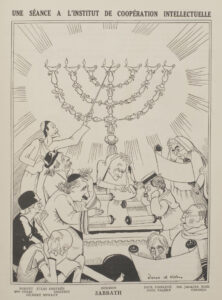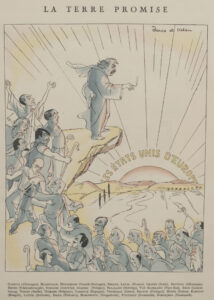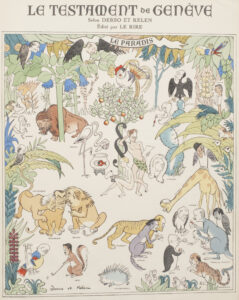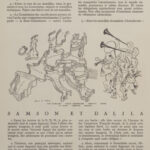The use of cameras was not permitted during deliberations at the League of Nations (1919-1947), but the press corps did include pictorial reporters, illustrators, and cartoonists. Among them were the creators of the Testament de Genève. After meeting in Lausanne, Switzerland, in 1922, Aloysius Derso and Emery Kelen, both Jewish expatriates from Hungary, would collaborate for some thirty years. Known for their humorous reports on current affairs and politics, they directed their gaze and their wit to the goings-on in the world of diplomacy at the League of Nations.
 In the Testament de Genève, Derso & Kelen’s goal was “to give the generation on which we rest our hopes instructive renderings of the first ten years of the international collaboration in Geneva.” They satirized the salient events and players of the first decade of the League of Nations, an organization they referred to as a “complicated system of rumors, like some scientific contraption.” They wrote parody and drew trenchant caricatures, and used elements of the Old Testament’s structure to organize the vicissitudes of politics both in conflict and in friendship.
In the Testament de Genève, Derso & Kelen’s goal was “to give the generation on which we rest our hopes instructive renderings of the first ten years of the international collaboration in Geneva.” They satirized the salient events and players of the first decade of the League of Nations, an organization they referred to as a “complicated system of rumors, like some scientific contraption.” They wrote parody and drew trenchant caricatures, and used elements of the Old Testament’s structure to organize the vicissitudes of politics both in conflict and in friendship.
Derso & Kelen’s common Jewish heritage informs this 1931 work just as it informed the work of their later careers: they would leave Europe in 1938 knowing all too well that their political commentary and cartoons left them openly vulnerable to the looming threat of Nazism. Having settled in New York City, they continued to ply their caricaturists’ talents in national magazines, in an effort to inform Americans of Hitler’s murderous depredations. In 1950 they would complete their United Nations Sketchbook, a cartoon history of the still-young UN.
Testament de Genève, a signed, limited-edition portfolio, contains black & white cartoons of people and events as well as splendid full-page plates, some of them hand-colored. Notable among these is a prescient image depicting, on the horizon, the emergence of what at the time was imaginable only as a cartoon: a unified Europe.



